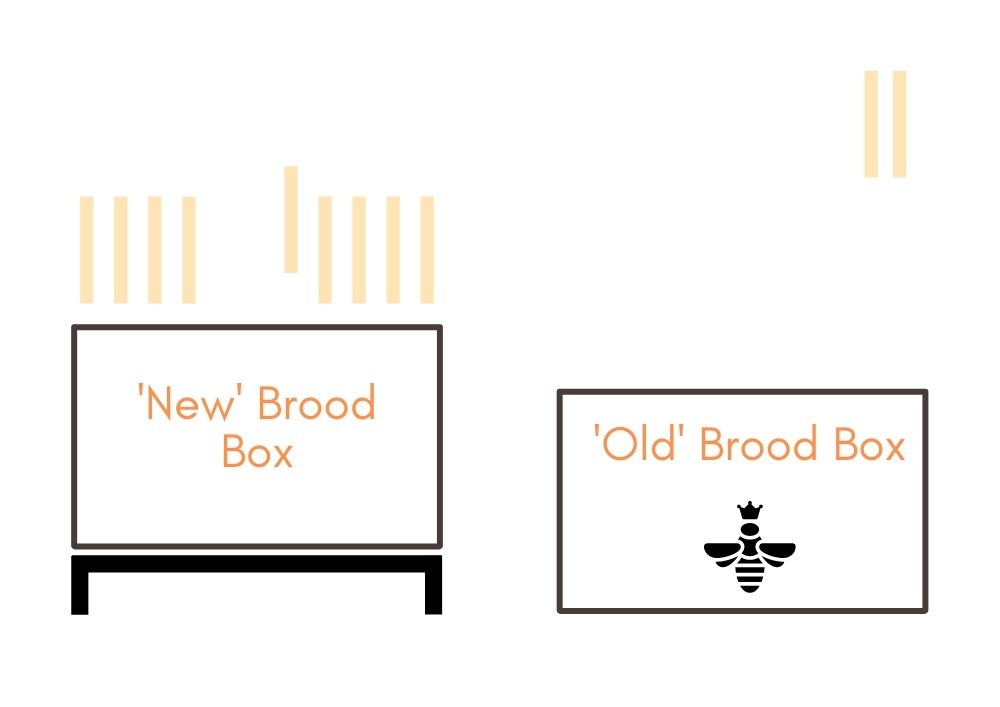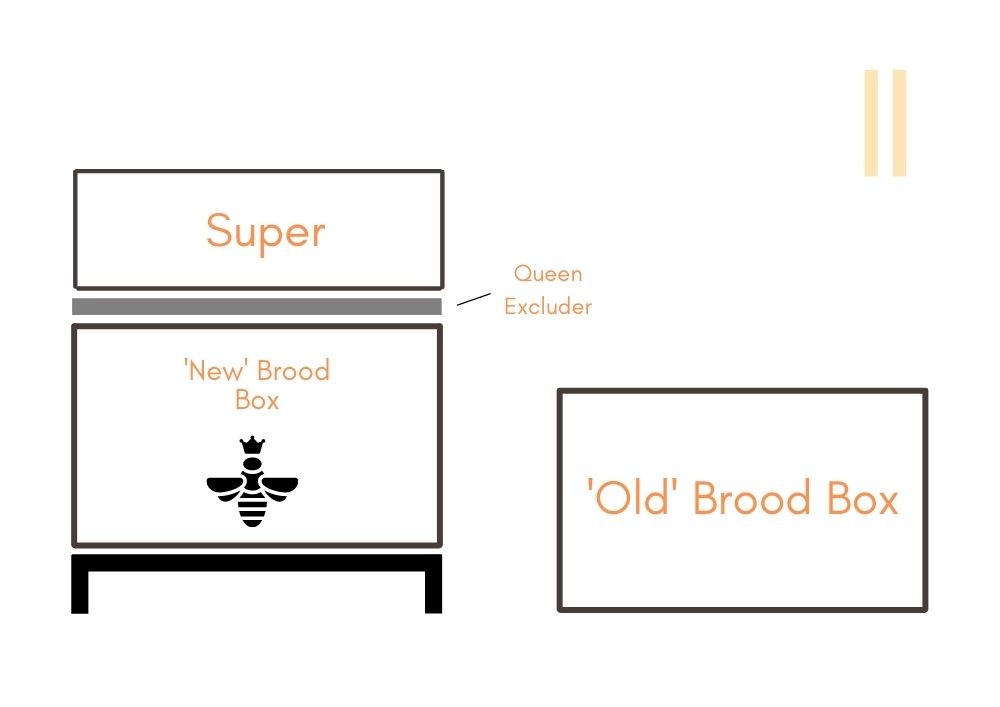The Demaree method is a popular method of swarm prevention invented by American George Demaree who published the details in the American Bee Journal in the late 1800s. It involves rearranging the boxes vertically before the signs of swarming occurs.
The idea behind the Demaree method, as with other swarm prevention models, is to separate the queen and the forager bees from most of the nursery bees.
As a result of this separation, the forager bees will believe the colony has swarmed because of the reduction in the number of the nursery bees – and the nursery bees will think the colony has swarmed because of the reduction in the number of the forager bees.
In effect, the queen and the colony have been ‘tricked’ into thinking that swarming has already taken place because congestion has been reduced, creating plenty of room for the queen to lay eggs.
The Demaree Method: A Step-By-Step Guide
The method is best applied when, after you examine your hive, you find that seven out of eight frames are full of brood, with bees covering most of the frames. When checking your hive, you should also look for any queen cells and remove them.
Here are the basic steps of the Demaree method:
- Remove the brood box from the base of the hive and put it carefully to one side.
- On the base, put a new (second) brood box filled with frames of empty drawn comb if you have them. If you don’t have enough to fill this new box, use as many as you have and place them in the center. Then, fill the outer gaps with frames with wax foundation.

- Take two frames of drawn comb from the center of this second brood box and put them to one side.

- Go back to the (first) brood box you removed from the base and find the queen.

- Place the queen and two frames of brood in the center of the brood box on the base. Most of the worker bees will remain in the box you removed from the base.

- Place a queen excluder on the second brood box with the queen.
- Above the queen excluder, put one or more empty supers (with frames) that will be used to store honey.

- Place another queen excluder above this honey super.
- In the first brood box, push the brood together and fill the outer gaps with the frames that you had removed in step 3.

- Place this box, which contains most of the worker bees, on top of the second queen excluder.

- Replace your hive mat (if using) and lid.

- After a week, remove the lid and look through the top brood box to remove any queen cells.
Does The Demaree Method Of Swarm Control Work?
Though I have not used it myself, many beekeepers have found that the Demaree method is a very effective swarm control technique.
As with other methods of swarm control, the Demaree works best if the beekeeper is observant, understands what is happening, knows what action to take and when to take it.
The Pros and Cons Of The Demaree Method
Pros Of The Demaree Method
The pros or advantages of the Demaree method are:
- It’s an effective method of swarm control.
- The colony is kept together in the hive which keeps it strong and able to produce a good honey crop.
- You can gain new queens should you want to increase your number of hives or replace an old queen in an existing hive. This is because the scent of the queen decreases in the top box and the bees may try to raise a new queen.
Cons Of The Demaree Method
The cons or disadvantages of the Demaree method are:
- It involves a lot of manipulation of heavy boxes.
- The queen may get injured or lost as the boxes are moved around.
- You have to keep an eye on the top box and remove any queen cells the bees make.
Methods Of Swarm Control
The urge to swarm is a natural impulse of the honeybee and is a part of their reproductive cycle.
Any method of swarm minimization works best if the beekeeper is observant, understands what is happening and knows what action to take and when to take it. The following are steps you can use to minimize swarming.
- Make sure your hive is not congested with bees. When you open the lid, are bees spilling out over the sides? Is each frame packed with bees? Time to give them more room.
2. Make sure your bees have plenty of room to store pollen and honey. If there is a strong honey flow, the bees will use the brood frames for storage, leaving less room for the queen to lay eggs. Remove the capped honey frames and replace them with an empty, drawn comb if you have them. Or use frames with wax foundation. Otherwise, you can add another super.
3. Provide sufficient ventilation so that the hive is kept cool on hot days.
4. Requeen your hive with a young healthy queen sourced from a reputable supplier. A young queen will rarely swarm until she is a year old.
5. Select a queen that is from a lineage that is less likely to swarm. Professional queen raisers rear queens with desirable traits and one of these could be a lower propensity to swarm.
Conclusion
Swarming is a natural part of the reproductive cycle of the European honeybee and it can be managed by careful observation and action by the beekeeper.
If you live in a suburban area with close neighbors, it’s important to take action to minimize the chance of your colony swarming. Most neighbors won’t be happy to receive a swarm of bees from your hive.
If you are a new beekeeper, it’s a great idea to find an experienced beekeeper from a local club who can help you during a hive inspection so you can understand what you are seeing and what you need to do about it.
